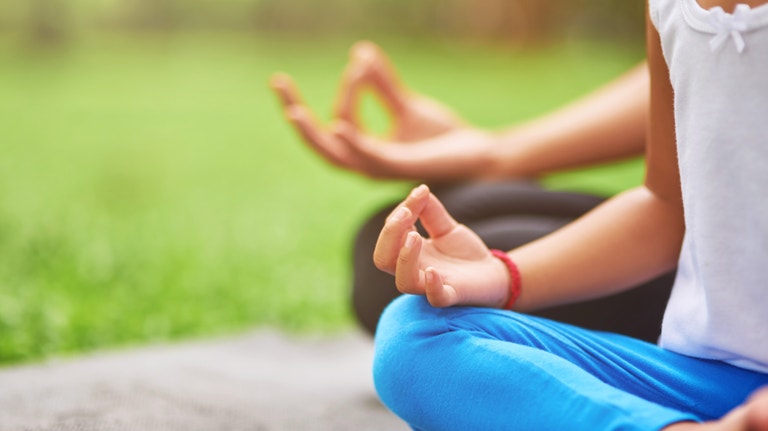
How To Start Meditating With Your Child
by Meghan Moravcik WalbertIf it seems like our kids are more scheduled, more anxious and more pressured than ever before, it’s because they probably are. It can be challenging for them (and us!) to find ways to unplug and relax. But for kids as young as preschool age, a few minutes of meditation every day can teach them how to stop, focus and breathe.
If you already meditate regularly yourself, you know the relaxing and de-stressing effects it can have on your mind and body. Kids can get those same benefits, the American Academy of Pediatrics says:
A number of studies in school settings also show improved attention and behaviour. Some research has shown benefits for attention deficit hyperactivity disorder (ADHD), anxiety, depression, school performance, sleep, behaviour problems, and eating disorders. For example, a trial of 300 low-income, minority urban middle-schoolers using school-based mindfulness instruction led to improved psychological functioning and lower levels of post-traumatic stress disorder (PTSD) symptoms.
There are also physical benefits as it calms the nervous system and decreases stress hormones. Studies have shown benefits for gastrointestinal symptoms, obesity, headaches, high blood pressure, pain sensitivity, and immune function.
And if you don’t already meditate but have been wanting to give it a try, you and your child can get started together.
Set a routine
Meditation may be especially helpful for kids at bedtime as a way to wind down from the day and relax their body and mind before falling asleep. But you might find that it’s actually more helpful for your child to do some wake-up meditations if they’re slow to get moving in the morning. Or right when they get home from school for a calming transition to their evening.
Whenever works best for you and your child is fine; the key is to incorporate it into a part of your daily routine. And these don’t need to be long sessions. Here are the time frames the AAP says are recommended by most paediatricians:
•
Preschool children: A few minutes per day.
•
Grade school children: 3-10 minutes twice a day.
•
Teens and adults: 5-45 minutes per day or more based on preference.
Pick a comfortable position in a quiet area of the home. This could be in a comfortable chair, sitting on the floor with your back up against the wall or lying down flat—whatever you prefer.
Find tools that work for you
For most people—and especially for kids who are just getting started—it can be helpful to learn the practice of meditation from a guide. There are lots of videos, apps, audio books and podcasts out there dedicated to helping you and your child meditate together. Here are a few of our favourites to check out to get you started:
Cosmic Kids! Yoga (YouTube)
Jaime at Cosmic Kids has a collection of videos for kids on yoga and mindfulness. Her “Peace Out” series offers short guided meditations for kids. Here are a few to check out:
- Time Out teaches kids to take a break and consider what they’re thinking and feeling and how to pay attention to their breathing (as a “zen ninja warrior” with “laser-sharp focus” would do).
- Friendly Wishes allows kids to imagine their kindness as the pebble that ripples on the surface of a lake. “May you be happy. May you be safe. May you be well.”
- Your Little Star helps kids imagine their own guiding star as their partner in making good choices.
(You might come to Cosmic Kids today for the meditation, but you’ll probably stay for the yoga. As Daniel in our Offspring Facebook Group says, “My kids love this channel. Getting my 5-year-old to sit still for more than 10 minutes can be a challenge, but he’ll rip off 45 mins of Cosmic Kids Yoga with no problem.”)
Once Upon a Quiet Time (audio book)
This audio book is more than an hour in length, broken up into 10-minute tales geared toward helping kids become mindful of their breathing and their body to relax before bedtime.
Daytime Explorers / Bedtime Explorers (podcasts)
The Daytime and Bedtime Explorers podcasts are meditation series designed to teach mindfulness techniques and soothe kids to sleep. Each episode in the daytime series is about 5-7 minutes long; episodes in the bedtime series are a little longer at 11-14 minutes, and all are led by the soothing voice of mindfulness coach Amy Taylor-Kabbaz.
Go Noodle’s “flow” channel (videos)
Your kids may already be familiar with Go Noodle from the videos their teachers are playing (and they are dancing to) in the classroom. But Go Noodle also has a section for families with a variety of channels you can play at home—including the “flow” channel. Flow offers ten different mindfulness videos with various meditation techniques for kids.
Headspace for Kids (app)
Headspace is one of the biggies in the space of guided meditation apps, so it’s only fitting they should have a library of meditations for kids. You can try a free 30-day trial of Headspace; after that, the cost is about $20 per month for access to kids’ meditations focusing on five themes: calm, focus, kindness, sleep and wake up (plus all the guided meditations for you). Kids’ sessions have been customised for three age groups: 5 and under, 6-8 and 9-12.
As your kids learn how to meditate, remind them that they can call on the techniques they’re learning during their meditation time in moments of stress, such as before a test at school, before they’re about to give a speech or when they’re experiencing a particularly strong emotion.